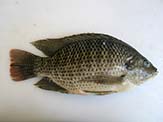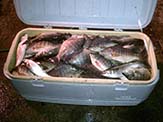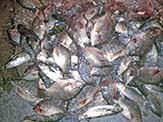Meats and Sausages
Tilapia
Fish RecipesTilapia, Protein-20.08%, Fat-1.70%, Water-78.08%
Tilapia is a very common fish that can be found in lakes, ponds, streams, rivers, and sometimes in brackish waters. Tilapia is a very widely eaten fish and is commercially farm raised. Their popularity is due to their ability to thrive in almost any water conditions (provided adequately warm temperatures). They grow quickly, reproduce often, and taste great. Tilapia keep lakes and ponds clean by eating vegetation, algae and mosquitos. This can be observed on golf courses where the lakes and ponds are always clean. However, some may find tilapia to be a nuisance. Tilapia reproduce often and grow very quickly taking over a lake or pond. They eat the eggs of other fish lowering their numbers. This is often the case of why and how a lake can run out of bass and other fish. Given time tilapia will overrun their habitats which is why they are an invasive species.
A small body of water can hold a huge number of tilapia. Fishermen like the fact that there are so many of them making them easy to catch. They are caught with cast nets all along the pond/lakes bank. Fishermen often catch them at night on golf course lakes and just blind throw a net. Blind throwing is when a fishermen randomly throws a cast net without seeing a fish. Fortunately the tilapia are plentiful around the bank and can be caught this way. Many lakes have drains connecting to saltwater bays or canals. In this case it is best to throw the cast net by the drain pipes as many fish gather near the flowing water and one can catch a netfull quite frequently. Additionaly with saltwater access a fisherman will often catch mullet in these lakes and an occasional snook.
In the United States, tilapia are found in much of Florida, Texas and Arizona. Tilapia is an important commercially farm raised fish and is processed into skinless, boneless fillets. Tilapia is excellent eating as its meat is firm and white. It tastes great baked, fried, broiled or grilled. Tilapia is found in most supermarkets but there is nothing fresher than catching them yourself.
Smoked Tilapia Fillet
- Fillet the fish.
- Brine the 1/2”fillets for 5 minutes in 80º brine. (Add 2.2 lbs of salt to 1 gallon of water. This makes 80 degrees brine). Wash and drain.
- Dry fillets for 60 minutes in a smokehouse preheated to 100° F (38° C).
- Smoke for 60 minutes at 185° F (85° C).




















